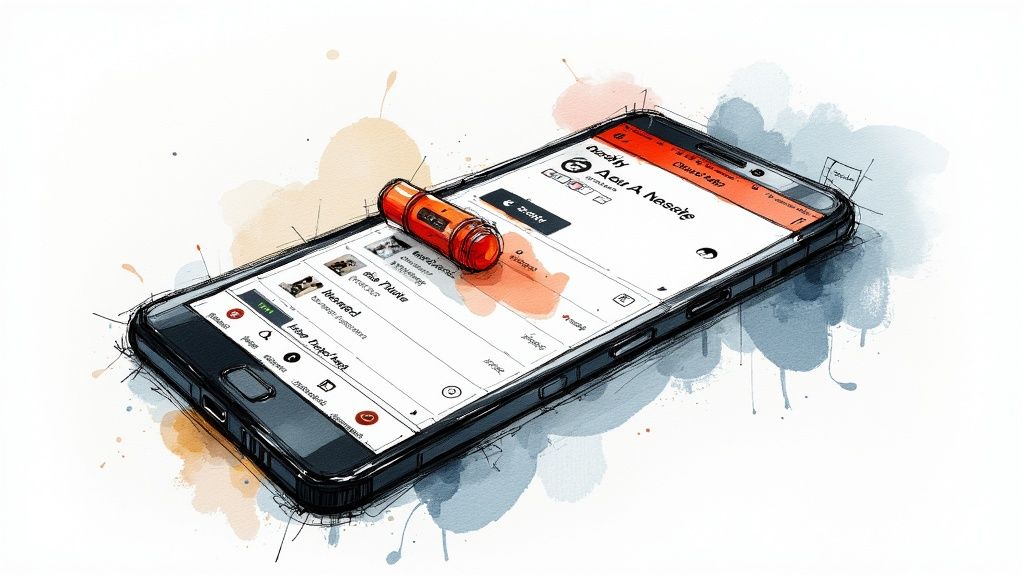How to Share Spotify Playlists: The Ultimate Guide to Music Curation
Understanding the Spotify Playlist Ecosystem

Spotify hosts an active community of music lovers who have created over 8 billion playlists to date. This massive collection shows just how central playlist sharing is to the platform's identity. In fact, users added 700 million new playlists in just the first half of 2024. To make the most of this thriving ecosystem, it's important to look beyond basic metrics like follower counts and understand the different types of playlists and how Spotify suggests music to listeners.
Different Types of Playlists
Each type of Spotify playlist serves a specific purpose, and knowing these differences helps you share music more effectively with your target audience:
- Personal Playlists: These private collections reflect your individual music taste and often focus on specific activities or moods. You might have playlists for studying, exercising, or enjoying your daily commute. These personal mixes can inspire themed playlists that you later share with others.
- Collaborative Playlists: Multiple users can add songs to these shared playlists, making them perfect for group events, projects, or building music communities. When collaborators share the playlist with their networks, it naturally reaches more listeners.
- Editorial Playlists: Created by Spotify's curation team, these influential playlists reach millions of listeners. Getting featured on an editorial playlist can significantly boost an artist's visibility - for example, "Today's Top Hits" has over 34.52 million followers, showing the major impact these playlists can have.
How Spotify's Recommendation System Works
The way Spotify suggests new music shapes how listeners discover and share songs. The platform creates personalized algorithmic playlists like "Release Radar" and "Discover Weekly" by analyzing your listening habits. "Release Radar" helps you stay current with new music from artists you follow, encouraging regular platform engagement. Meanwhile, "Discover Weekly" introduces you to a wider range of artists and genres, giving emerging musicians a chance to find new fans. When sharing playlists, it helps to understand these algorithms - creating playlists that work well with Spotify's recommendation system increases their chances of being discovered by more listeners.
Mastering Essential Sharing Techniques
Effectively sharing Spotify playlists requires more than just hitting "Share." With over 8 billion user-created playlists on Spotify in 2024 and 700 million new additions in just six months, understanding the nuances of different sharing methods is key to helping your playlists reach the right audience. This section explores the full range of Spotify's sharing tools and how to use them strategically.

Sharing Across Different Platforms
Spotify makes it simple to share playlists wherever your listeners are - on phones, computers, or the web. This flexibility ensures your music reaches people on their preferred devices and platforms.
Mobile Sharing: The Spotify mobile app lets you share directly through text messages, social media, and messaging apps like WhatsApp. For instance, sending a workout playlist to a gym buddy takes just one tap, making spontaneous music sharing effortless.
Desktop Sharing: While the desktop version offers similar sharing options, it adds the ability to copy playlist URIs and drag-and-drop links. This makes it easy to share playlists in emails, forum posts, or any other online space. The desktop interface gives you more control over how and where you share.
Web Embedding: For a more integrated experience, you can embed a full Spotify player directly on a website or blog. This allows visitors to play your playlist without leaving the page, adding an interactive element to your content. A music blog post featuring an embedded themed playlist, for example, creates a richer experience for readers.
Creating Custom Share Links and URIs
Spotify provides tools to customize how your playlists appear when shared, letting you create the exact experience you want for your listeners.
Custom Share Links: You can set specific starting points within playlists or highlight particular sections. This control helps guide the listener's experience - for example, starting with the perfect mood-setting track that captures the playlist's essence.
URI Sharing: Each Spotify playlist has a unique URI (Uniform Resource Identifier) that ensures listeners access the exact version you intend to share. This precision is especially valuable for collaborative playlists where everyone needs to work from the same version.
The ability to share playlists effectively is central to what makes Spotify work as a social music platform. By mastering these sharing techniques, you can ensure your carefully curated playlists find their audience and stand out among the billions of playlists on Spotify. As we'll explore next, the key is creating playlists that grab and hold attention once shared.
Crafting Playlists That Capture Attention
Creating playlists that people want to share takes more than just randomly grouping songs together. With over 8 billion user-created playlists on Spotify, yours needs to stand out to get noticed and shared. Let's explore the key elements that make playlists truly compelling and worth sharing.
The Psychology of a Great Playlist Title
Just like a book title, your playlist name creates the first impression. A good title does double duty - it hints at the musical experience while making your playlist easy to find. Skip generic names like "Workout Music" in favor of specific, evocative titles like "Sunrise Run" or "Powerlifting Pump." The right title sets expectations and helps your playlist show up when people search for specific kinds of music.
Writing Descriptions That Draw Listeners In
Your playlist description explains the story behind your song selection. Rather than a basic label like "Chill music," paint a picture of the listening experience. For example: "Unwind after a long day with these mellow acoustic tracks and ambient soundscapes. Perfect for a cozy night in." This helps listeners understand exactly what mood and moment your playlist is made for.
Visual Appeal: Choosing the Right Cover Image
An eye-catching cover image helps your playlist get noticed in a crowded feed. Popular playlists like "Today's Top Hits" use fresh, trendy visuals that match their musical style. Pick images that reflect your playlist's character - bright and bold for upbeat pop, or subtle and artistic for introspective collections. High-quality visuals encourage sharing and help listeners find playlists that match their tastes.
Song Selection and Sequencing: Creating a Cohesive Listening Experience
The heart of any great playlist is how the songs work together. Think of your playlist as a musical journey, with each track leading naturally to the next. Popular curators, like those behind Spotify's "RapCaviar," carefully plan the energy flow from song to song. Mix up the pace to keep things interesting - start strong, ease into mellower tracks, then build energy again. This approach works especially well for activity-based playlists like road trip or study soundtracks. When songs flow together smoothly, listeners are more likely to share your playlist with friends.
Building Your Playlist Promotion Strategy

Getting your playlists noticed on Spotify takes focused effort and smart promotion. With over 8 billion user-created playlists competing for attention, you need more than just great music curation - you need a clear plan to reach and grow your audience. Here's how to effectively share your playlists and build an engaged community around your music selections.
Leveraging Social Media and Music Communities
Social platforms provide key opportunities to showcase your playlists. Share eye-catching visuals on Instagram Stories with direct Spotify links to make discovery simple. Find and join music discussions in genre-specific communities on Reddit or Facebook where your curated playlists add real value. Being selective about where you promote helps you connect with listeners who appreciate your musical perspective. When sharing in these spaces, highlight what makes your playlist special for that specific audience and why they'll want to check it out.
Engaging Your Personal Network and Building Authentic Connections
Start building momentum by sharing with people who already know and trust your taste. Reach out to friends, family and colleagues with personal messages explaining the story behind your playlist. Their initial support and feedback provides valuable insights. But growing a true community requires ongoing engagement - join conversations about the tracks, respond thoughtfully to comments, and create an welcoming space for music lovers to connect. This organic approach encourages your core listeners to naturally spread the word.
Cross-Promotion and Collaboration: Expanding Your Reach
Team up with other playlist curators in your genre to expand your reach. Arrange mutual features and social media mentions to tap into each other's audiences. This cooperative approach lets you access new listener bases while helping fellow curators grow theirs. The artists in your playlists can also become powerful allies - many are happy to promote playlists featuring their music, multiplying your promotional impact. By working together, everyone involved can expand their visibility.
Creating Shareable Moments and Encouraging Organic Growth
Spark natural sharing by giving people compelling reasons to talk about your playlist. Host themed online listening sessions, run creative contests, or develop playlist-related social content that your audience will want to share. For example, start conversations by asking listeners to post their current favorite track using a custom hashtag. When you focus on genuine engagement and bringing real value, your playlists become more than just collections of songs - they become catalysts for music discovery and community building that people naturally want to share.
Leveraging Data For Playlist Growth

Growing successful Spotify playlists requires more than just sharing them widely - it demands a deep understanding of how listeners interact with your music selections. By analyzing data and metrics about listener behavior, you can make informed decisions to refine your playlists and build a larger, more engaged audience.
Understanding Playlist Analytics
Spotify provides valuable insights through its platform, particularly for those with Spotify for Artists accounts. The analytics show exactly how listeners engage with your playlists - from skip rates and repeat plays to average listening duration. For instance, you can see which songs keep people listening and which cause them to move on. This data reveals clear patterns in your audience's preferences and helps measure your playlist's overall performance through metrics like follower growth and share counts.
Interpreting Listener Behavior
The true value of playlist data comes from understanding the story it tells. Each listener action - whether skipping tracks, repeating songs, or following playlists - provides meaningful feedback. When certain songs have high skip rates, it may signal they don't match the playlist's intended mood or flow. On the other hand, tracks that get frequent replays are clearly resonating with your audience. By studying these behavioral patterns, you can align your playlist more closely with what your listeners want.
Refining Your Curation Strategy With Data
Once you grasp how listeners respond to your playlists, you can make targeted improvements to your sharing approach. If the data shows people prefer certain song sequences or tempos, adjust your track ordering accordingly. When you notice listeners gravitating toward specific genres or moods, use those insights to guide future song selections. This continuous cycle of analyzing data and refining your playlists based on real listener feedback is what helps successful curators grow their following.
Testing and Optimizing for Spotify's Algorithm
Like search engines ranking web pages, Spotify's algorithm determines which playlists to recommend to users. The platform looks at engagement metrics like average listening time and skip rates to assess playlist quality. Playlists that keep listeners engaged are more likely to be suggested to others. Try experimenting with different themes, genres and song arrangements while tracking performance to discover what best captures listener interest. With over 8 billion playlists on Spotify, using data to optimize for the algorithm helps your carefully curated selections stand out and reach more listeners organically.
Sustaining Long-Term Playlist Success
Like any successful creative project, a popular Spotify playlist requires ongoing care and attention to maintain its momentum. Building strong initial audience engagement is just the first step - the real challenge lies in keeping your playlist relevant, engaging, and growing over time. This involves paying close attention to your listeners' preferences, staying on top of emerging music trends, and consistently delivering fresh content that resonates with your audience.
Content Planning and Refreshing Your Playlists
The key to keeping listeners coming back is maintaining the perfect balance between familiar favorites and exciting new discoveries. Regular updates help prevent playlist fatigue while preserving the core identity that attracted followers in the first place. For instance, if you curate a workout playlist, you might add one or two trending workout anthems each week while keeping the proven motivational tracks that your audience loves.
Seasonal and thematic playlists provide another effective way to stay relevant. Creating collections for specific occasions like summer beach days, cozy winter evenings, or major holidays gives listeners a compelling reason to engage with your content throughout the year. This approach helps you tap into natural listening patterns while keeping your overall playlist portfolio fresh and dynamic.
Engaging Your Audience and Building a Community
The most successful playlists foster genuine connections with their listeners. Take time to respond to comments, ask for song suggestions, and create opportunities for real interaction. Spotify's RapCaviar playlist exemplifies this approach - they've built a dedicated following by actively engaging with hip-hop fans and highlighting up-and-coming artists. This two-way dialogue helps you understand what your audience wants while making them feel like valued contributors to the playlist's evolution.
Gathering regular feedback is essential for keeping your finger on the pulse of your community. Consider using social media polls or music forum discussions to learn which songs are hitting the mark and which ones might need refreshing. When listeners feel heard and see their input reflected in playlist updates, they're more likely to become long-term followers who actively share your playlists with others.
Adapting to Trends and Algorithm Changes
Success on Spotify requires staying informed about both music trends and platform updates. Pay attention to emerging genres, rising artists, and shifts in listening habits. Study how algorithmic playlists like Discover Weekly connect listeners with new music, and apply those insights to your own curation strategy. Being adaptable while maintaining your playlist's core identity is crucial for long-term growth.
Consider experimenting with different content formats to keep things interesting. This might mean incorporating relevant podcast episodes or creating themed series that tell a musical story. Use the analytics available through Spotify for Artists to track what's working and adjust your approach accordingly. The most successful playlist curators are those who can evolve while staying true to their original vision.
For creators looking to simplify their online presence management, Linkero offers an effective solution. This platform lets you create a central hub for all your playlists and social media profiles, making it easier for listeners to find and follow your content across different platforms.


